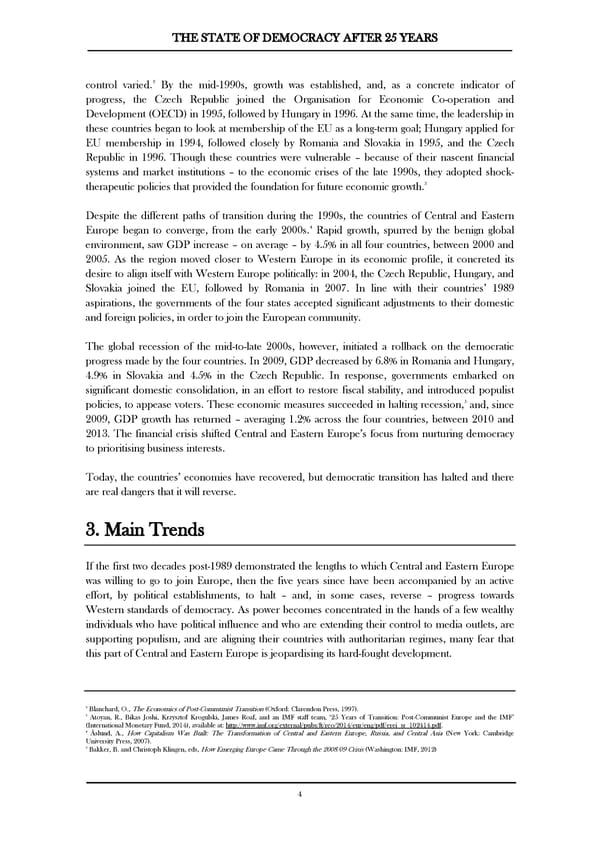THE STATE OF DEMOCRACY AFTER 25 YEARS control varied.2 By the mid-1990s, growth was established, and, as a concrete indicator of progress, the Czech Republic joined the Organisation for Economic Co-operation and Development (OECD) in 1995, followed by Hungary in 1996. At the same time, the leadership in these countries began to look at membership of the EU as a long-term goal; Hungary applied for EU membership in 1994, followed closely by Romania and Slovakia in 1995, and the Czech Republic in 1996. Though these countries were vulnerable – because of their nascent financial systems and market institutions – to the economic crises of the late 1990s, they adopted shock- therapeutic policies that provided the foundation for future economic growth.3 Despite the different paths of transition during the 1990s, the countries of Central and Eastern Europe began to converge, from the early 2000s.4 Rapid growth, spurred by the benign global environment, saw GDP increase – on average – by 4.5% in all four countries, between 2000 and 2005. As the region moved closer to Western Europe in its economic profile, it concreted its desire to align itself with Western Europe politically: in 2004, the Czech Republic, Hungary, and Slovakia joined the EU, followed by Romania in 2007. In line with their countries’ 1989 aspirations, the governments of the four states accepted significant adjustments to their domestic and foreign policies, in order to join the European community. The global recession of the mid-to-late 2000s, however, initiated a rollback on the democratic progress made by the four countries. In 2009, GDP decreased by 6.8% in Romania and Hungary, 4.9% in Slovakia and 4.5% in the Czech Republic. In response, governments embarked on significant domestic consolidation, in an effort to restore fiscal stability, and introduced populist policies, to appease voters. These economic measures succeeded in halting recession,5 and, since 2009, GDP growth has returned – averaging 1.2% across the four countries, between 2010 and 2013. The financial crisis shifted Central and Eastern Europe’s focus from nurturing democracy to prioritising business interests. Today, the countries’ economies have recovered, but democratic transition has halted and there are real dangers that it will reverse. 3. Main Trends If the first two decades post-1989 demonstrated the lengths to which Central and Eastern Europe was willing to go to join Europe, then the five years since have been accompanied by an active effort, by political establishments, to halt – and, in some cases, reverse – progress towards Western standards of democracy. As power becomes concentrated in the hands of a few wealthy individuals who have political influence and who are extending their control to media outlets, are supporting populism, and are aligning their countries with authoritarian regimes, many fear that this part of Central and Eastern Europe is jeopardising its hard-fought development. 2 Blanchard, O., The Economics of Post-Communist Transition (Oxford: Clarendon Press, 1997). 3 Atoyan, R., Bikas Joshi, Krzysztof Krogulski, James Roaf, and an IMF staff team, ‘25 Years of Transition: Post-Communist Europe and the IMF’ (International Monetary Fund, 2014), available at: http://www.imf.org/external/pubs/ft/reo/2014/eur/eng/pdf/erei_sr_102414.pdf. 4 Åslund, A., How Capitalism Was Built: The Transformation of Central and Eastern Europe, Russia, and Central Asia (New York: Cambridge University Press, 2007). 5 Bakker, B. and Christoph Klingen, eds, How Emerging Europe Came Through the 2008/09 Crisis (Washington: IMF, 2012) 4
 The State of Democracy After 25 Years Page 4 Page 6
The State of Democracy After 25 Years Page 4 Page 6